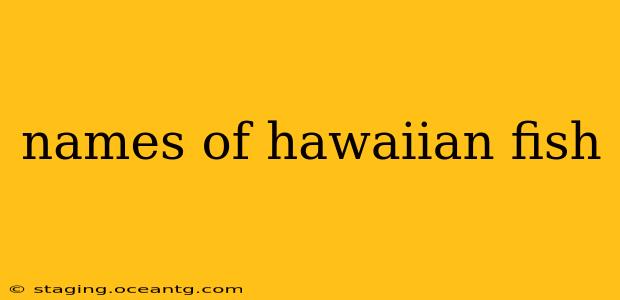Hawaii's waters teem with an incredible diversity of fish, each with its own unique name and story. From the brilliantly colored reef dwellers to the deeper-dwelling pelagic species, the archipelago boasts a rich marine ecosystem. This guide explores some of the most recognizable and fascinating Hawaiian fish, delving into their characteristics and significance to the islands' culture and environment.
What are some common Hawaiian fish names?
Many Hawaiian fish names are descriptive, reflecting the fish's appearance, behavior, or habitat. For example, 'humuhumunukunukuāpuaʻa' (reef triggerfish) is a long name that literally translates to "the fish that snorts like a pig." This perfectly captures the fish's appearance and behavior. Other common names include:
- Wahoo: A fast and powerful pelagic fish prized for its delicious flesh.
- Mahi-mahi (Dolphin fish): A vibrant, colorful fish often found near floating objects.
- Opakapaka (Red Snapper): A deep-water fish known for its bright red color and flaky meat.
- 'Ahi (Yellowfin Tuna): A highly prized game fish and a staple in Hawaiian cuisine.
- Menehune (various small fish): Often used as a general term for small, colorful reef fish, similar to how "minnow" is used in other regions. The specific meaning can depend on context and regional dialect.
What are some rare or unusual Hawaiian fish?
Beyond the commonly known species, Hawaii's waters hold many rare and unusual fish. These often require specialized knowledge to identify, and sightings are frequently treasured by marine biologists and divers. Some examples include:
- Honu (Sea Turtle): While not technically a fish, the honu is an integral part of Hawaiian marine life and deserves mention. Its various species hold cultural significance.
- Various species of Anglerfish: Deep-sea dwellers with bioluminescent lures, they are rarely seen but represent the unique biodiversity of the deeper ocean around Hawaii.
- Various species of Eels: From the Moray eels that inhabit coral reefs to the more elusive species found in deeper waters, eels are a significant part of the Hawaiian ecosystem.
- Endemic species: Numerous fish species are endemic to Hawaii, meaning they are found nowhere else on Earth. Research into these species is ongoing, and new discoveries are still being made.
What are the scientific names of Hawaiian fish?
Scientific names provide a universal classification system for organisms, avoiding confusion caused by regional variations in common names. While this article focuses on common Hawaiian names, it's important to note that each fish also has a scientific binomial nomenclature (genus and species). For example:
- Humuhumunukunukuāpuaʻa: Rhinecanthus rectus
- Wahoo: Acanthocybium solandri
- Mahi-mahi: Coryphaena hippurus
How are Hawaiian fish names important to Hawaiian culture?
Hawaiian fish names are deeply intertwined with Hawaiian culture and traditions. They often reflect the relationship between the people and the ocean, highlighting the importance of marine resources for sustenance and spirituality. The names themselves are often part of traditional stories and legends, adding another layer of significance to these creatures.
Why are Hawaiian fish important to the ecosystem?
Hawaiian fish play a critical role in maintaining the health of the coral reef ecosystems. They contribute to the balance of the food web, helping to control algae growth and maintain biodiversity. The decline of certain fish populations can have cascading effects on the entire ecosystem, highlighting the importance of conservation efforts.
Where can I find more information about Hawaiian fish?
Several resources provide comprehensive information about Hawaiian fish, including academic journals, marine biology websites, and books on Hawaiian marine life. Local aquariums and marine research institutions also offer valuable insights into the fascinating world of Hawaiian fish.
This exploration only scratches the surface of the diverse and captivating world of Hawaiian fish. Further research will reveal even more fascinating species and their significance to the unique Hawaiian ecosystem. By understanding and appreciating these creatures, we can work towards preserving their vibrant presence in the islands' waters for generations to come.
